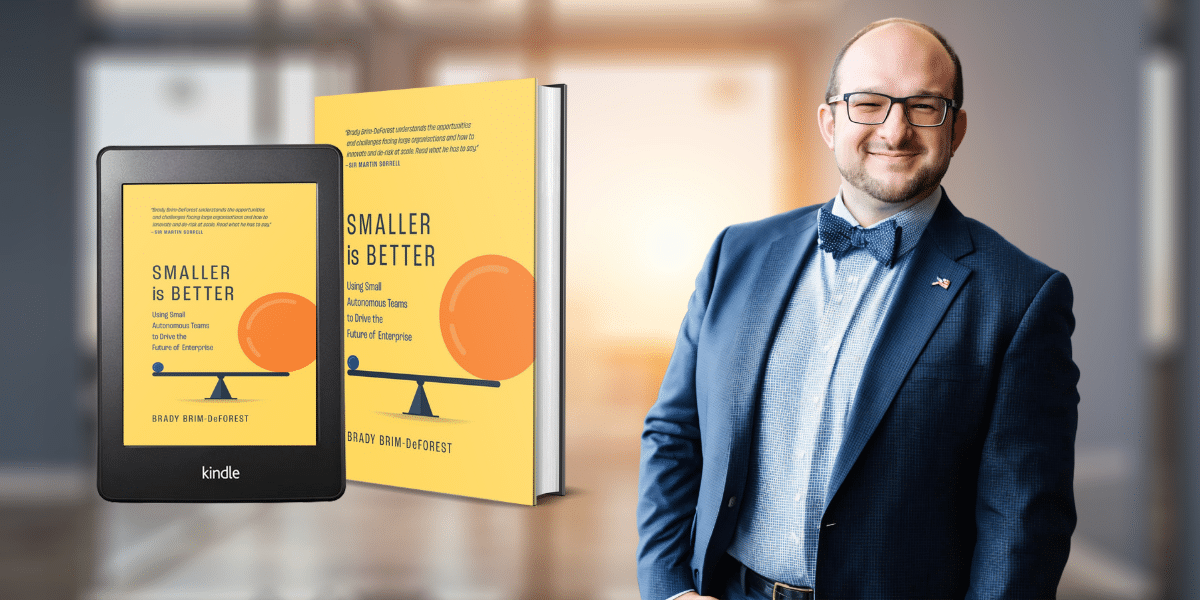By: Stephanie Martinez
Brady Brim-DeForest, a renowned author and organizational strategist, explores the transformative potential of optimizing teams to achieve mission-focused results in this exclusive interview. He advocates for the congruence of team missions with overarching strategic objectives in his recent book, “Smaller is Better,” which he investigates through a structured, sequential approach. Brim-DeForest’s insights demonstrate the potential of smaller, autonomous teams to foster innovation and agility, particularly in a market landscape that is swiftly evolving as a result of technological advancements. He underscores the scalability of this approach across a variety of sectors and organizational sizes, drawing from personal experiences and industry-wide observations. Aiming to cultivate a culture of strategic alignment, resilience, and continuous improvement, readers are encouraged to investigate actionable steps for implementing these principles. Brady Brim-DeForest will impart his knowledge on the utilization of small teams to achieve substantial, enduring success.
Your book highlights the importance of optimizing teams for missions. Could you elaborate on how organizations can align team missions with overall strategic objectives?
For organizations aiming to align team missions with overall strategic objectives, a phased approach offers a structured path:
- Foundation Phase: Start by assembling your teams, defining the mission along with sub-missions, setting clear values and expectations, establishing productive work habits, and beginning to practice autonomy.
- Trust and Feedback Phase: Focus on building mutual trust within the team, deepening the level of responsibility and autonomy, incorporating real-time feedback, and laying the groundwork for a culture of self-improvement.
- Building on Success Phase: Shift attention to managing stakeholders, implementing radical transparency starting with people, then extending to budgets and organizational data.
Each phase builds on the last, reinforcing the team’s autonomy, enhancing their ability to contribute meaningfully to the organization’s strategic goals, and fostering a dynamic of continuous improvement and adaptation.
How do you see the concept of “smaller is better” evolving in the context of rapidly changing market dynamics and technological advancements?
As technology accelerates and market demands shift more quickly, small, autonomous teams are better positioned to adapt and innovate due to their inherent agility. This structure allows for a more direct and efficient response to changes, leveraging technological tools to enhance productivity and decision-making. Thus, in an environment characterized by constant evolution, smaller teams can maintain a competitive edge by being more aligned with the pace of change, demonstrating that the principles of “smaller is better” are not only relevant but increasingly critical for success in today’s fast-paced market.
Could you share any personal anecdotes or experiences that shaped your understanding of the principles you advocate in your book?
We had secured a significant opportunity, worth over $15 million, and deployed a team led by an incredibly capable leader named Chris. Chris devised a new resourcing model that heavily depended on one individual, introducing a significant risk. Despite our concerns, we decided to support Chris’s autonomy and responsibility for the outcome, aligning with our teams model.
Unfortunately, the strategy failed spectacularly, leading to our dismissal by the client—a profoundly difficult day for all involved. Following this, Chris submitted his resignation, which I refused to accept. Instead, I emphasized the invaluable lesson learned from this failure, highlighting Chris’s newfound experience and insights as assets to our team
This approach not only saved Chris’s job but also led to his significant professional growth and the implementation of transformative changes within our organization.
Rewarding Chris for taking a risk and learning from failure underlined the value we place on experience and learning. It reinforced his commitment to the organization and positively influenced his approach to leadership and decision-making. This experience profoundly shaped my understanding of resilience, learning from failure, and the importance of empowering individuals within a team.
What are your thoughts on the scalability of the small teams approach across different industries and organizational sizes?
The scalability of the small teams approach across different industries and organizational sizes is not only viable but transformative. By focusing on building small autonomous units, organizations can maintain the agility, innovation, and responsiveness necessary to thrive in diverse environments. This model functions beautifully, whether it involves three teams or a thousand, because it mimics a living, lightweight organism that grows and sustains itself through self-healing and self-evolving mechanisms. Each team functions independently yet in concert with the whole, ensuring that the organization can scale without losing the agility and innovative capacity that smaller teams offer. By emphasizing autonomy, cross-functional capabilities, and a focus on missions with measurable impacts, the approach fosters a competitive advantage that is difficult to match, moving organizations forward faster and more sustainably with dramatically better outcomes.
Finally, what do you hope readers will take away from “Smaller is Better,” and what actionable steps can they implement based on your insights?
For readers looking to implement the “Smaller is Better” approach in their organizations, here are key takeaways/action items to consider:
- Start Small: Begin by creating a sandbox experiment. This means starting with a small, contained project that allows you to test the principles of “Smaller is Better” without overhauling your entire organization. This controlled environment will enable you to demonstrate success on a manageable scale.
- Enlist Support: After establishing success with your initial experiment, enlist stakeholder support and gather additional resources based on this success. Gaining buy-in from key stakeholders is crucial as it provides the necessary backing to scale the approach across the organization.
- Expand Carefully: Once your initial team or project has proven successful, carefully begin to incubate new teams, ensuring they can operate autonomously before adding more to the mix. This gradual expansion ensures that each team is fully prepared to embrace the principles of autonomy and effectiveness characteristic of “Smaller is Better”. Limit the scope of each addition to maintain manageability and focus on depth rather than breadth in the early stages to solidify the foundation of success.
By focusing on these steps, organizations can methodically implement “Smaller is Better”, transforming their operations to be more agile, innovative, and responsive to change.
Website: https://brimdeforest.com
LinkedIn: https://www.linkedin.com/in/bradybd/
Smaller is Better: Using Small Autonomous Teams to Drive the Future of Enterprise
Published by: Khy Talara



















